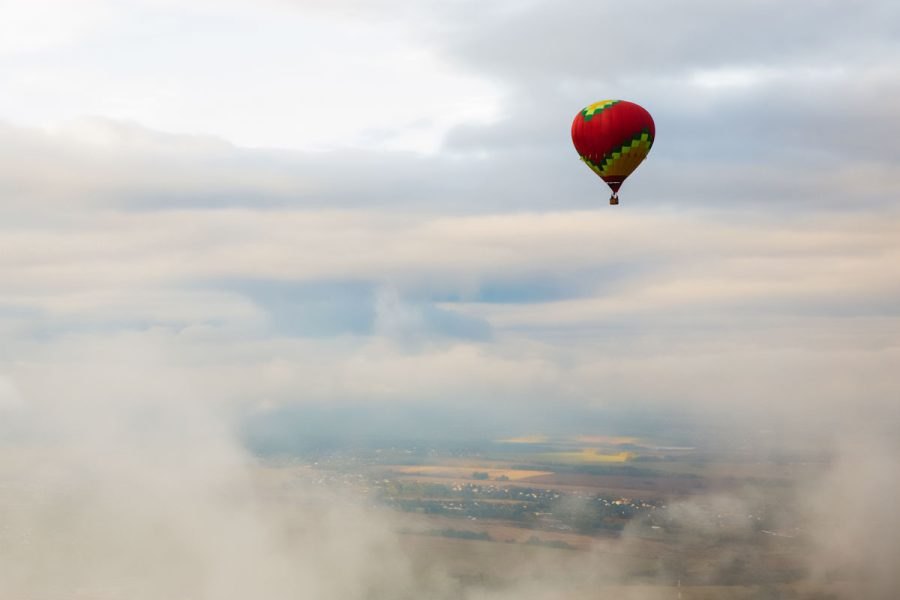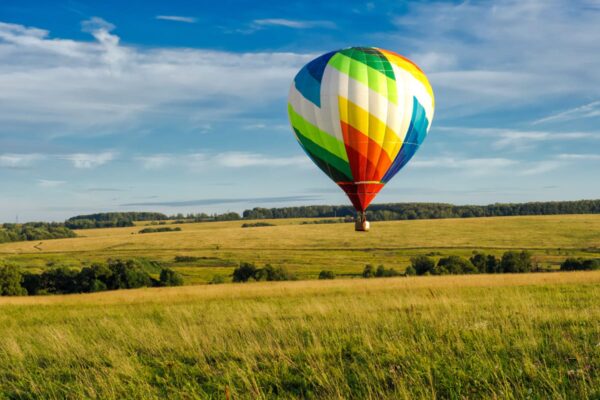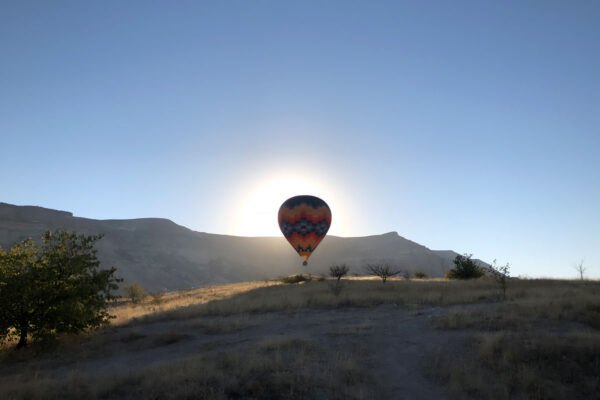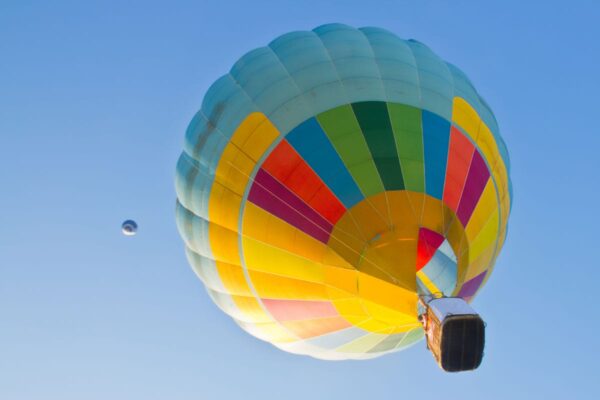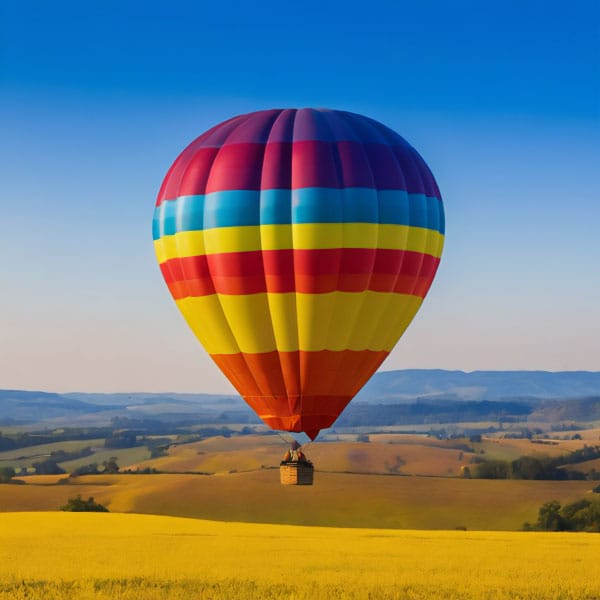A balloon flight is an extraordinary experience that allows you to see the world from a completely different perspective. Hovering in the skies gives you a sense of freedom and allows you to enjoy panoramic views inaccessible from the ground. Choosing the right season for such an adventure is crucial for flight comfort and safety. Each season offers a different visual experience – from the blooming fields of spring, to the luscious greens of summer, to the golden hues of autumn. Weather conditions change with the seasons, which directly affects the ability to take a flight.
Hot air balloons require stable weather conditions, which most often occur at dawn or before dusk. This is when the air is coolest and most stable, and the winds are mildest. The balloon flying season in Poland usually runs from March to October, but experienced pilots can fly year-round if conditions permit. Winter balloon flights, although rarer, offer exceptional views of snowy landscapes and crystal-clear air.
When planning a balloon flight, it is worth considering not only the time of year, but also the specific weather conditions on the day. Rain, strong wind or fog may prevent the balloon from taking off for safety reasons. Therefore, when booking a flight, be flexible and ready for possible date changes.
Spring balloon flights offer spectacular views of waking nature
Spring is a time when nature awakens to life after its winter slumber. Balloon flights during this time allow you to observe this fascinating process from a bird’s eye view. From March to May, the landscape undergoes a dynamic transformation that delights with a variety of colors and forms.
An explosion of colors
The spring awakening of nature creates an extraordinary color palette visible from the balloon basket. The luscious green of young leaves contrasts with the variety of colors of flowering plants. Yellow fields of rapeseed stretching to the horizon create spectacular views, especially in April and May. Flowering apple and cherry orchards are covered with a white and pink carpet of flowers, creating a fairy-tale landscape.
Flights in spring allow observation of the awakening fauna. From the balloon you can spot animals coming out into the fields and meadows after their winter rest. Deer, hares or foxes are more active in the morning, which increases the chance of observing them during the flight.
Weather stability
The spring months, especially April and May, are often characterized by stable weather conditions in the morning. Cool nights and gradually warming days create ideal conditions for balloon flights. At that time, the air is usually calm and winds are mild, which is conducive to safe takeoffs and landings.
The temperature in the basket of the balloon in spring can be slightly cooler than on the ground, especially during morning flights. It’s a good idea to dress in layers so you can adjust your clothing to the changing conditions. A light jacket, hat and gloves may be essential, even if the weather on the ground is already warm.
Best places for spring balloon flights in Poland:
- Narew River Valley – the floodplains of the river create a picturesque water maze
- Kazimierz Dolny area – spring hills covered with blooming orchards
- Jura Krakowsko-Czestochowska – rocky outcrops emerging from the greenery
- Bieszczady Mountains – mountain meadows and forests waking up to life
Challenges of spring flights
Spring is also a period of changeable weather. Sudden changes in weather conditions can lead to more frequent flight cancellations. Transient rainfall, which is typical for this time of year, makes safe balloon flight impossible. A wet balloon becomes heavier and more difficult to steer, and visibility deteriorates significantly during rainfall.
April and May are the months with greater temperature differences between day and night. This can lead to morning fog, which delays the balloon’s launch. On the other hand, floating above the fog can create a magical sight as the sun breaks through the milky coating.
Tip: When planning a spring balloon flight, it’s a good idea to book some alternative dates. The weather during this period can be capricious, so flexibility increases the chances of taking a flight under optimal conditions.
Summer mornings provide ideal weather conditions for sky adventures
Summer is traditionally the peak season for balloon flights in Poland. From June to August, atmospheric conditions are mostly favorable, and long days make it possible to organize flights both at dawn and before dusk. Summer mornings offer a unique experience for lovers of sky adventures.
Stability of the air at dawn
Summer mornings are characterized by exceptional air stability. Just after sunrise, when the ground has not yet had time to warm up, conditions for balloon flights are optimal. The air is then the coolest and most stable, which translates into a smooth and calm flight. Minimal turbulence keeps passengers comfortable and allows precise control of the balloon.
The temperature in the morning in summer is pleasant – not too cold as in early spring or autumn, but also not as hot as at midday. Thermal comfort during the flight is important, as there is no shelter from the cold or heat in the balloon basket. Morning flights in the summer avoid the afternoon heat, which could reduce the enjoyment of the flight.
Excellent visibility
Summer mornings often offer excellent visibility, especially after the passage of a weather front. The clear, transparent air allows you to see details of the landscape from great distances. Visibility reaching tens of kilometers is not uncommon, making it possible to admire vast panoramas.
The intense colors of the summer landscape are especially attractive from the perspective of the balloon. Green forests, golden fields of grain and colorful fields of flowers create a mosaic of colors. The rising sun adds a magical glow to this picture, creating ideal conditions for photography.
Advantages of summer morning balloon flights:
- Stable, calm air that minimizes turbulence
- Comfortable temperature – not too cold, not too hot
- Excellent visibility for enjoying expansive panoramas
- Long day giving more opportunities to postpone the flight if necessary
- Minimal risk of fog and haze limiting visibility
Evening flights in summer
In addition to mornings, summer also offers excellent conditions for evening balloon flights. As the heat of the day subsides and the air becomes more stable, a second weather window favoring ballooning opens up. The setting sun creates a spectacular play of light and shadow on the landscape, giving it a golden glow.
Evening flights have their own unique charm. Watching the shadows lengthen as the sun sets and the landscape takes on warm colors is an unforgettable experience. For photographers, this is a unique opportunity to capture the magical light of the golden hour from an unusual perspective.
Tip: It’s always a good idea to carry headgear and sunglasses when taking a summer balloon flight. The sun in the morning can shine straight into your eyes, and at an altitude of several hundred meters its rays are more intense than on the ground.
Autumn landscapes make a picturesque backdrop during a balloon flight
Autumn is the time when nature prepares for its winter rest, offering the most colorful views of the entire year. Balloon flights from September to November allow you to admire this fever of colors from the best possible perspective – from a bird’s eye view.
A palette of autumn colors
Autumn forests seen from the basket of a balloon delight with a wealth of colors. Reds, oranges, yellows and browns mix with the remnants of summer green, creating a natural mosaic. Mixed forests are particularly beautiful, where each tree species takes on a different hue. Maples shimmer with red, birches with gold, and oaks with deep brown.
Post-harvest fields form geometric patterns in shades of brown and gold. The plowed fields contrast with the meadows, which still retain their green color. This patchwork of colors and textures is best seen just from the height of the balloon flight, where one can see the vast panoramas and patterns created by nature and man.
Ideal weather conditions
Autumn, especially September and early October, often brings stable high pressure systems. This means days with cloudless skies, good visibility and mild winds – ideal conditions for balloon flights. Cooler air in autumn means that the balloon needs less energy to rise, which translates into longer and more economical flights.
Morning fog, typical of autumn, can initially delay takeoff, but often creates magical scenery. Hovering in a balloon above a milky coating of fog, from which only the tops of trees and hills emerge, is an experience like a fairy tale. As the sun breaks through the fog, the landscape gradually emerges, offering balloon passengers a unique spectacle.
The most beautiful places for autumn balloon flights in Poland:
- Bory Tucholskie – vast forest complexes shimmer with autumn colors
- Masuria – lakes reflecting colorful forests create a double palette of colors
- Bóbr Valley – picturesque meanders of the river among golden forests
- Swietokrzyskie Mountains – a mosaic of forests and fields on hilly terrain
Late autumn brings greater challenges for balloon flights. Starting in mid-October, the weather becomes more unpredictable, with more frequent rainfall and stronger winds. Shorter days also limit the time windows available for flights, especially for those working standard hours.
Temperatures during autumn flights can be significantly cooler than in summer. At an altitude of several hundred meters, the perceived temperature is usually several degrees lower than on the ground. Warm clothing becomes essential – layered clothing, a hat, gloves and warm boots will ensure comfort throughout the flight.
Tip: Autumn balloon flights are best planned in advance for September or early October. During this period, the weather is most stable and the colors of nature are most intense. Later dates carry a greater risk of flight cancellation due to unfavorable conditions.
Professional balloon flights with ProBallooning
ProBallooning is a company specializing in organizing professional balloon flights in Poland. Founded by a pilot with more than ten years of experience and about 500 flights to his credit, it offers safe and unforgettable adventures in the skies. The company is distinguished by its individual approach to customers and attention to the highest safety standards.
ProBallooning Company
ProBallooning was born out of a passion for ballooning. The company’s founder began his ballooning adventure with sport flying, which is the typical path for most pilots. Currently, in addition to conducting commercial flights, he remains an active member of the balloon section of the Lublin Aeroclub and regularly participates in Polish Cup competitions.
The ProBallooning team is made up of experienced pilots with full ratings and a wealth of experience. Among them is Aline, a Brazilian-born pilot who grew up in a family with 30 years of ballooning traditions. Her international experience from balloon festivals and competitions in Brazil, Peru, Japan, the US, Armenia, Poland and Germany adds a global perspective to the company’s offerings.
The company operates mainly in the regions of Warsaw, Radom and Lodz, offering passengers the opportunity to enjoy picturesque landscapes, including the Vistula and Pilica rivers and the Bolimowski Landscape Park. All flights take place in small, intimate groups, ensuring comfort and individual attention to each passenger.
Flight offerings
ProBallooning offers a variety of balloon flights, tailored to the needs and expectations of customers. Each flight ends with a traditional “air baptism” and the presentation of an Aeronaut certificate as a memento of this unique experience.
Types of flights available at ProBallooning:
- Scenic flights – allowing you to enjoy panoramic landscapes
- Private flights – an exclusive option for those seeking an intimate atmosphere
- Family flights – a great opportunity to spend time with loved ones
- Engagement flights – a unique setting for your proposal
A standard balloon flight with ProBallooning is a comprehensive experience that includes an equipment inspection and passenger training prior to the flight, an hour-long flight over scenic landscapes, refreshments at the landing site, a toast to a successful landing, baptism and certification as an Aeronaut, and return transportation to the venue. The entire event takes about 3-4 hours, and the flight itself takes about 60 minutes.
ProBallooning attaches great importance to passenger safety and comfort. The balloons used by the company are regularly inspected and maintained to the highest standards, ensuring complete safety during the flight. Each balloon is EU-certified and subject to compliant maintenance.
The company’s experienced pilots are fully certified and have extensive knowledge and skills to ensure a smooth and safe flight. Before takeoff, each participant is instructed on safety rules, adding to the sense of comfort.
The balloon baskets are designed with passenger comfort in mind, offering spaciousness and stability. For comfort, a maximum of 5-8 passengers are taken into the balloons, depending on the type of flight.
Customer reviews
ProBallooning enjoys very good customer reviews, as evidenced by a rating of 5.0 based on 200 positive reviews. Customers emphasize the professionalism of the crew, the safety of the flights and the unforgettable experience of adventure in the skies.
Many customers note the friendly atmosphere throughout the event, from the pre-flight meeting to the celebration after landing. Particularly appreciated is the individual approach to each passenger and the passion with which the pilots share their knowledge of ballooning and the passing landscapes.
Tip: When booking a flight with ProBallooning, it’s worth inquiring about the possibility of aerial photography. The company offers professional in-flight photography services to capture this unique experience without having to focus on operating the camera.
How weather affects the safety of balloon flights at different times of the year
Weather is a key factor affecting the safety of balloon flights. Unlike airplanes, balloons cannot avoid unfavorable weather conditions – they must wait for those conditions to improve. Each season brings specific weather challenges that can affect flight safety and comfort.
Wind – a major risk factor
Wind is the most important factor affecting balloon flights. Balloons fly best in stable and light winds between four and six miles per hour. They never take off in winds exceeding 12 miles per hour (about 19 km/h).
Strong winds can not only damage the balloon, but also cause the pilot to miss the target, cause a hard landing and require more landing space. There are periods of stronger winds in spring and autumn, which can lead to more frequent flight cancellations. Summer usually offers the most stable wind conditions, especially early in the morning.
High altitude winds (winds occurring at higher altitudes) can also cause flight cancellations. On the ground, it can be nearly breezy, but at altitude winds can blow at 20 miles per hour. Pilots must also take these conditions into account when making flight decisions.
Precipitation and storms
Balloons do not take off during rain. Precipitation can damage the balloon and reduce visibility. Rain also cools the hot air inside the balloon, making it harder to control. A wet balloon becomes heavier and more difficult to control.
Thunderstorms pose a particular danger to balloons. According to safety rules, there must be no thunderstorms within 100 miles (about 160 km) of the launch site. A lightning strike on a balloon poses an extremely dangerous threat. In addition, scour fronts can occur up to 100 miles ahead of a thunderstorm or line of thunderstorms, which could significantly affect the balloon.
Weather hazards at different times of the year:
- Spring: sudden weather changes, fleeting rainfall, changing wind directions
- Summer: thermal storms, strong rising currents, local violent phenomena
- Autumn: fogs that limit visibility, early frosts, stronger winds
- Winter: icy equipment, short days, extreme temperatures
Balloon pilots operate under VFR (Visual Flight Rules) conditions. This means that they must have a certain amount of visibility in order to fly. Depending on the location of the flight, visibility must be at least 1 to 3 miles. Flying in fog is virtually impossible.
Fogs are especially problematic in spring and fall, when the temperature differences between day and night are greatest. Morning fog can delay a balloon’s launch, but often dissipates as the sun rises. In winter, with stable, frigid air, visibility can sometimes be the best of the year, which makes up for the other challenges of this time of year.
Atmospheric fronts
There may be no atmospheric fronts in the area of the planned balloon flight. Fronts usually involve a change in wind direction or increased wind speed. If pilots can plan for this in advance, a launch may be possible. However, if the front is to pass during the flight, the launch must be canceled.
In winter, weather fronts are often more pronounced and intense, which can lead to more frequent flight cancellations. Summer is characterized by fewer fronts, but a greater risk of local thermal storms, which can also prevent a flight.
Tip: When booking a balloon flight, it’s always a good idea to have a plan B and be flexible with your dates. Even in the best season, the weather can change, and safety is always a priority for professional balloon operators.
Best months to book a balloon flight in Poland
Choosing the right month for a balloon flight in Poland can significantly affect the quality of the experience. Each month offers different weather and scenic conditions to consider when planning this unique adventure.
The main season: May-September
The months of May through September represent the main season for balloon flights in Poland. During this period, weather conditions are most stable and temperatures are pleasant both in the morning and evening. Statistically, these months see the fewest flight cancellations due to inclement weather.
June, July and August are the months with the longest days. This gives more flexibility in scheduling flights, both morning and evening. Early sunrises allow balloon launches as early as 4:30-5:00 am, which can be a challenge for some, but the reward is spectacular views at dawn.
May and September offer the golden mean – the days are still long enough, the temperatures are pleasant, and the morning launches take place at more affordable hours (around 5:30-6:00 am). Additionally, there are fewer tourists during these months, which translates into more available dates and a more intimate experience.
Transition months: April and October
April and October are transitional months that can offer an exceptional balloon experience, but carry a greater risk of flight cancellation. The weather during these months is more unpredictable, with more frequent rainfall and stronger winds.
April brings the first signs of spring – blooming trees, fresh greenery and awakening nature. Flights during this month offer unique views not available at other times of the year. However, changing weather conditions can lead to more frequent flight cancellations.
October delights with autumn colors, which are especially spectacular from a bird’s eye view. Forests shimmer with shades of red, gold and brown, creating an unforgettable landscape. However, shorter days and greater weather instability limit the time windows available for flights.
Comparison of months in terms of conditions for balloon flights:
- July – most stable weather, longest days, highest temperature
- August – stable weather, long days, high temperature
- June – long days, moderate temperature, risk of thunderstorms
- May – longer days, moderate temperature, nature in bloom
- September – stable weather, moderate temperature, beginning of autumn colors
- April – awakening nature, changeable weather, cooler mornings
- October – autumn colors, shorter days, changeable weather
- March – first signs of spring, colder mornings, changeable weather
- November – late autumn, short days, often inclement weather
- February – wintry landscapes, very cold mornings, limited flight availability
- January – coldest month, short days, limited flight availability
- December – shortest days, cold mornings, festive atmosphere
Winter season: November-March
The months of November through March constitute the winter season for balloon flights in Poland. Flights are less frequent during this period due to more difficult weather conditions and shorter days. However, winter balloon flights offer a unique experience for the most persistent enthusiasts.
Winter air is denser, which means the balloon requires less energy to rise. This translates into longer flights with the same fuel consumption. In addition, winter air is often crystal clear, providing exceptional visibility and the ability to enjoy panoramas from great distances.
The challenge of winter flights is the low temperatures, which can be felt even more at an altitude of several hundred meters. Appropriate warm clothing that does not restrict movement is essential. The short winter days also significantly limit the available time windows for flights, which must take place in daylight.
Tip: When booking a balloon flight in Poland, it’s best to aim for the months of May through September, with a special focus on July and August, when weather conditions are most stable. Those who are flexible with time may consider April or October, which offer unique views at a slightly higher risk of flight cancellation.
Summary
Choosing the best season for a balloon flight depends on a number of factors, including landscape preference, weather tolerance and time flexibility. Each season offers a unique experience – spring delights with awakening nature, summer provides stable weather conditions, and autumn tempts with a feast of colors. Winter flights, although less frequent, reward with crystal clear visibility and unique views of snow-covered landscapes.
The most important factor affecting the safety and comfort of a balloon flight is the weather. Wind, precipitation, visibility and weather fronts determine the feasibility of a flight. Professional operators like ProBallooning always put safety first, even if it means cancelling a scheduled flight.
Statistically, the best months for a balloon flight in Poland are from May to September, with a peak in July and August. During this time, weather conditions are the most stable and the days are the longest, increasing the chances of making the flight as planned. The transitional months of April and October offer unique views with a slightly higher risk of cancellation.
When planning a balloon flight, it’s a good idea to be flexible and prepared for possible date changes. Weather is unpredictable and a flight can be postponed even at the last minute. Professional operators always offer to reschedule the date or refund the cost if the flight is canceled for weather reasons.
Regardless of the season chosen, a balloon flight remains an unforgettable experience that allows you to see the world from a completely different perspective. Hovering in the skies, the silence interrupted only by the hum of the burner and the panoramic views create a magical experience that remains in the memory for a long time.
